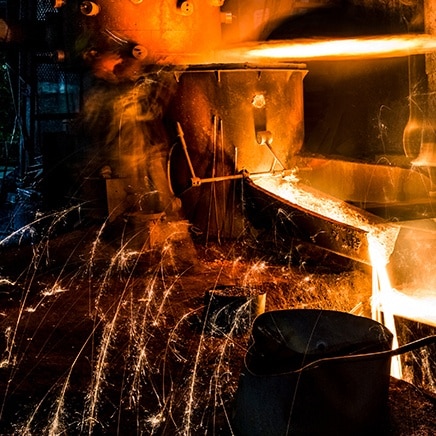
Control valves are used to change process conditions such as flow, temperature, level, and pH. A complete control system would include: a sensor, controller, positioner or current to pressure transducer, and control valve. Globe valves, such as the Dwyer Series 2000VA/ 3000WA Hi-Flow™ Control Valve, are a very common type of control valve.
The Dwyer Hi-Flow™ Series control valves have pneumatic actuators that modulate the valve for flow control. The opening, closing and throttling of the valve plug is accomplished by varying the air pressure to the diaphragm in the actuator. Typically the control pressure signal is 3 to 15 psig. There are two types of actuators: Air-To-Lower and Air-To-Raise.
In Air-To-Lower actuators, as the pressure signal is increased, the diaphragm pushes down, moving the stem and plug down, and compressing the range spring. As the pressure signal is decreased, the range spring pushes the diaphragm up, moving the valve stem and plug up.
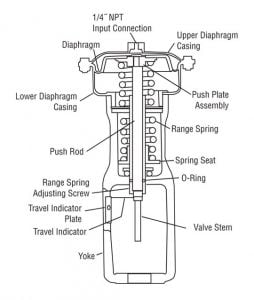 Air-to-Lower Actuator
Air-to-Lower ActuatorIn Air-To-Raise actuators, as the pressure signal is increased, the diaphragm pushes up, moving the stem and plug up, and compressing the range spring. As the pressure signal is decreased, the range spring pushes the diaphragm down moving the valve stem and plug down.
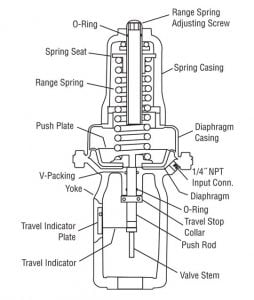
Air-to-Raise Actuator
The Hi-Flow™ Control Valve Series offers two types of valve bodies, Push-To-Close, and Push-To-Open.
In Push-To-Close, the valve stem moves downward, pushing the valve plug closer to the seat in the valve body. This movement decreases the flow through the valve.

Push-to-Close Linear Valve Body
In Push-To-Open, the valve stem moves downward, pushing the valve plug away from the seat in the valve body. This movement increases the flow through the valve.
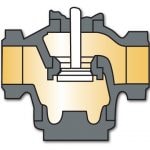
Push-to-Open Linear Valve Body
With the choice of actuators, Air-To-Raise or Air-To-Lower, and valve bodies, Push-To-Close or Push-To-Open, the proper action of the valve can be selected for the application, direct acting or reverse acting. Consideration should also be taken for the fail position of the valve, which is what the valve will do on loss of the control signal air.
A Push-To-Close valve body with an Air-To-Raise actuator will have a valve action of Air-To-Open and spring closed. This is a normally closed valve and is reverse acting.
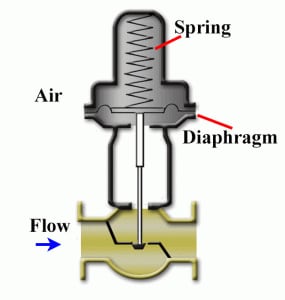
Air-to-Open, Spring Closed Normally Closed
A Push-To-Open valve body with an Air-To-Lower actuator will have a valve action of Air-To-Open and spring closed. This is a normally closed valve and is reverse acting. It has the added safety factor that the upstream pressure will close the valve on control signal air loss.
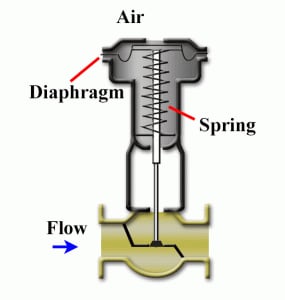
Air-to-Open, Spring Closed Normally Closed
A Push-To-Open valve body with an Air-To-Raise actuator will have a valve action of Air-To-Close, spring open. This is a normally open valve and is direct acting.
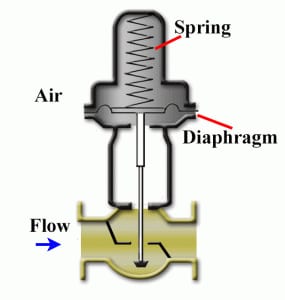
Air-to-Close, Spring Open Normally Open
A Push-To-Close valve body with an Air-To-Lower actuator will have a valve action of Air-To-Close, spring open. This is a normally open valve and is direct acting. It has the added safety factor that the upstream pressure will open the valve on control signal air loss.
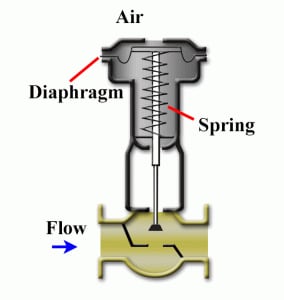
Air-to-Close, Spring Open Normally Open
The actuator must be sized to be large enough to shut-off the valve against system pressure on the valve plug. The Hi-Flow™ Series is offered in three actuator sizes with a variety of range spring sizes, according to the shut-off pressure needed. Valve sizing charts show the maximum shut-off pressure for each size valve with each size actuator.
When ordering a valve, the maximum upstream pressure will need to be specified and the spring size is automatically chosen accordingly. The range spring has an operating range of shut-off pressures that it will operate with, and the actuator has an adjustment for field calibration for shut-off pressure within that spring range. It is best to adjust the valve in the application so that it operates at the particular shut-off pressure in the application line.
